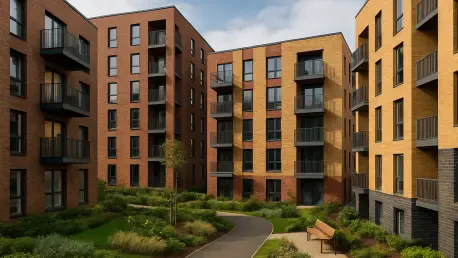In the ever-evolving landscape of the UK housing market, a seismic shift is underway as the build-to-rent (BTR) sector emerges as a vital solution to the twin challenges of soaring rental demand and dwindling affordability for homeownership. This innovative model, particularly in the realm of single-family homes (SFHs), offers a promising path to meet the needs of a growing renter population seeking space and community over cramped urban apartments. Yet, amidst this potential, a critical gap persists between demand and supply, with developers and investors struggling to navigate financial and regulatory hurdles. Enter mortgage brokers, the unsung heroes poised to bridge this divide by connecting small and medium-sized enterprise (SME) developers with tailored financing solutions. Their expertise and strategic partnerships are becoming indispensable in transforming underutilized land into sustainable suburban communities, addressing a housing crisis that affects millions across the nation.
Shifting Dynamics in Rental Housing Demand
The UK rental market is witnessing a profound transformation, with tenant preferences driving a marked shift from high-rise urban apartments to suburban single-family homes in the build-to-rent sector. Recent data from industry analysts reveals that SFHs now account for over half of BTR investments, a dramatic increase from just a fraction a few years ago. This pivot reflects a growing desire among the majority of renters—over 50% of whom reside in suburban areas—for larger living spaces, private gardens, and a stronger sense of community. However, the supply of such homes remains woefully inadequate. With only a small fraction of the needed annual units completed in recent years against a backdrop of escalating demand, the opportunity for developers to fill this void is immense. The challenge lies in mobilizing the resources and expertise to bring these projects to fruition, particularly in regions where housing shortages are most acute.
Beyond the numbers, the trend toward suburban BTR developments signals a deeper cultural shift in how families and individuals envision their living environments. Commuter towns and regional hubs, often rich with underused sites, are becoming prime targets for these projects as they offer proximity to urban centers alongside the benefits of quieter, more spacious neighborhoods. For developers, this presents a unique chance to create housing that aligns with modern lifestyle demands while addressing systemic shortages. Yet, the complexity of financing such ventures often deters smaller players from entering the market. Navigating this landscape requires not just capital but a nuanced understanding of local needs and long-term sustainability. Mortgage brokers, with their ability to tailor financial strategies, are increasingly seen as pivotal in ensuring that these opportunities do not slip through the cracks, enabling projects that might otherwise remain on the drawing board.
The Pivotal Role of Mortgage Brokers
Mortgage brokers stand at the forefront of the build-to-rent revolution, acting as essential conduits between SME developers, investors, and specialized lenders. Their deep understanding of the single-family home BTR market allows them to guide clients toward scalable projects that meet both tenant needs and financial viability. By identifying underutilized land in strategic locations like commuter belts, brokers help developers envision phased developments that can grow over time. Moreover, their ability to secure innovative financing options, such as revolving credit facilities, ensures that capital remains fluid—allowing completed homes to be refinanced into stabilization loans as they are rented out. This approach not only reduces borrowing costs but also frees up funds for subsequent project phases, creating a sustainable cycle of development that benefits all stakeholders in the housing ecosystem.
Equally important is the brokers’ role in fostering partnerships with lenders who offer flexible financial products tailored to the unique demands of BTR projects. Such collaborations are crucial for SMEs, which often lack the financial clout of larger developers but possess invaluable local knowledge and agility. Brokers adept at navigating these relationships can mitigate the risks associated with mixed-tenure or phased developments, ensuring that projects remain on track despite economic or regulatory headwinds. Their expertise extends beyond mere financing to a broader advisory capacity, helping clients anticipate market trends and align their strategies with tenant expectations. As the demand for suburban rental homes continues to surge, the strategic input of brokers becomes a linchpin in turning visionary ideas into tangible communities, thereby addressing one of the most pressing challenges in the UK housing sector today.
Navigating Regulatory and Financial Challenges
Despite the promise of the build-to-rent sector, significant obstacles remain, particularly in the form of regulatory constraints that impact development costs and design flexibility. Legislation such as requirements for additional safety features in taller buildings, while critical for protecting residents, often increases expenses and limits the feasibility of certain urban projects. As a result, many developers are turning to low-rise suburban schemes as a more viable alternative, where such regulations pose less of a burden. This shift underscores the need for adaptive strategies that balance safety with affordability, ensuring that housing delivery does not stall under the weight of compliance. Brokers play a vital role here, advising clients on how to pivot toward more feasible project models without sacrificing quality or community impact.
On the financial front, access to capital remains a persistent barrier, especially for smaller developers eager to enter the BTR space. Proposals for initiatives like a National Housing Bank aim to address this by offering lower-cost funding and reducing early-stage risks, with a target of delivering hundreds of thousands of new homes over the coming years. For such policies to have a meaningful impact, accessibility for SMEs must be prioritized, allowing those with local expertise to drive regional development. Mortgage brokers are instrumental in ensuring that these opportunities reach the right hands, advocating for financing structures that support phased growth and long-term stability. By aligning policy support with practical financial solutions, the industry can overcome systemic challenges, paving the way for a more robust supply of rental housing that meets the diverse needs of the UK population.
Building Sustainable Communities for Tomorrow
Reflecting on the strides made in the build-to-rent sector, it has become evident that mortgage brokers have emerged as indispensable allies in addressing the UK’s housing crisis. Their ability to connect SME developers with innovative financing has already begun to transform underutilized suburban spaces into thriving rental communities. Partnerships with specialized lenders have proven effective in overcoming financial barriers, while a focus on regional hubs has helped meet the growing demand for family-friendly housing. Regulatory challenges, though daunting, have been navigated with strategic pivots toward low-rise developments, showcasing the adaptability of the industry.
Looking ahead, the path to sustainable growth in BTR hinges on continued collaboration between brokers, developers, and policymakers. Exploring new financing models that further reduce risks for SMEs could accelerate project timelines, while targeted policy interventions might unlock additional land for development. Strengthening broker networks to share best practices and market insights will also be crucial in scaling up delivery. By focusing on these actionable steps, the sector can build on past achievements to create lasting solutions, ensuring that the dream of accessible, high-quality rental housing becomes a reality for future generations across the UK.









